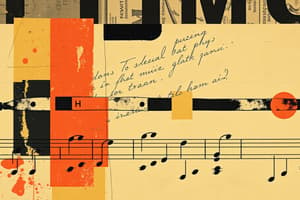Podcast
Questions and Answers
What is pitch?
What is pitch?
The perceived highness or lowness of a musical sound.
Which of the following conditions allows pitch to be useful? (Select all that apply)
Which of the following conditions allows pitch to be useful? (Select all that apply)
- Be a part of a series of pitches that forms a logical unit of music—MELODY. (correct)
- Be a part of two or more logical series of pitches sounded in contrast with each other—COUNTERPOINT. (correct)
- Be a part of several pitches sounded at the same time—HARMONY. (correct)
- Be a single isolated pitch.
What is a theme in music?
What is a theme in music?
A central melody in a musical work.
What does counterpoint refer to in music?
What does counterpoint refer to in music?
What are modulations in music?
What are modulations in music?
What is dissonance?
What is dissonance?
What defines a melody?
What defines a melody?
What are phrases in music?
What are phrases in music?
What is imitation in music?
What is imitation in music?
What characterizes a canon in music?
What characterizes a canon in music?
What is harmony?
What is harmony?
What is a tonal center?
What is a tonal center?
What is the scale in music?
What is the scale in music?
What is a chord?
What is a chord?
What is a tonic chord?
What is a tonic chord?
What does the term 'interval' refer to?
What does the term 'interval' refer to?
What is an octave?
What is an octave?
What defines a Major scale?
What defines a Major scale?
What defines a Minor scale?
What defines a Minor scale?
What is consonance?
What is consonance?
What are cadences in music?
What are cadences in music?
What is texture in music?
What is texture in music?
What is monophonic music?
What is monophonic music?
What is homophonic music?
What is homophonic music?
What is polyphonic music?
What is polyphonic music?
Flashcards are hidden until you start studying
Study Notes
Music Terminology and Concepts
-
Pitch: Refers to the perceived highness or lowness of a musical sound.
-
Functional Pitch Conditions:
- Melody involves a series of pitches forming a coherent unit.
- Counterpoint contrasts multiple logical series of pitches.
- Harmony consists of several pitches sounding simultaneously.
-
Theme: The central melody of a musical composition.
-
Counterpoint: Melodic interdependence often involving imitation and contrast.
Tonality and Harmony
- Modulation: The shift in tonal center during a piece, resulting in a change of key.
- Dissonance: A combination of sounds perceived as harsh or disagreeable.
- Melody: A cohesive sequence of consecutive pitches.
- Phrases: Logical shorter segments of music, akin to clauses in language.
- Imitation: Repetition of a theme or motif in another part or shortly after.
- Canon: A form of music where lines imitate each other throughout the piece.
- Harmony: The combination of multiple pitches, creating chords that accompany a melody.
Musical Structures
- Tonal Center: The pitch around which a piece of music is centered.
- Key: Refers to the tonic or root note of a scale.
- Scale: A defined series of pitches that ascend or descend based on specific patterns.
- Chord: Combination of three or more pitches sounded together.
- Tonic Chord: Built on the first degree of a major or minor scale.
- Interval: Measures the distance between two pitches.
Scales and Modes
- Octave: Relationship of pitch where one frequency is double or half that of another.
- Major Scale: Comprises seven distinct pitches within an octave with specific half-step placements.
- Minor Scale: Also consists of seven pitches, differing in half-step arrangement.
Sound Qualities
- Consonance: Simultaneous sounds perceived as agreeable or restful.
- Cadences: Melodic or harmonic formulas that signal the end of a phrase.
- Texture: The arrangement of melody and harmony into forms such as monophonic, homophonic, or polyphonic.
Texture Types
- Monophonic: One melodic line without accompaniment.
- Homophonic: A primary melody supported by accompanying harmony.
- Polyphonic: Multiple melodic lines of similar importance played simultaneously.
General Principles
- Sound arises from vibrating molecules in the air.
- The rate of vibration determines pitch; more rapid vibrations yield higher pitches.
- Musical notes are designated by the first seven letters of the alphabet, repeated in each octave.
- Higher and lower pitches from the same note differ in their frequency, being either halved or doubled.
- Melody is formed from consecutive pitches and can be segmented into phrases, influenced by harmony and instrumentality.
- Most music centers on a tonal note, with frequent modulations occurring throughout compositions.
- Scales establish the tonal foundation for music, with major and minor scales providing a contrasting musical character.
Textural Understanding
- Modern music predominantly features homophonic texture; polyphony includes forms of imitation like canons, or simultaneous melodic lines.
Studying That Suits You
Use AI to generate personalized quizzes and flashcards to suit your learning preferences.




